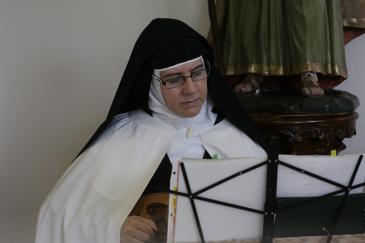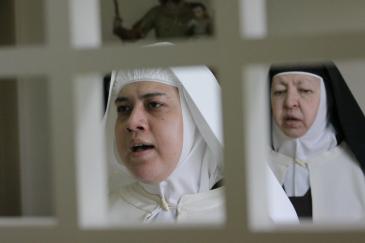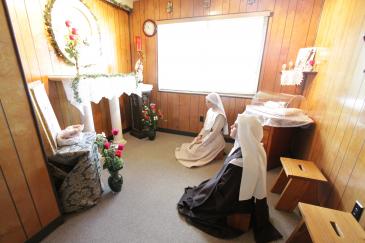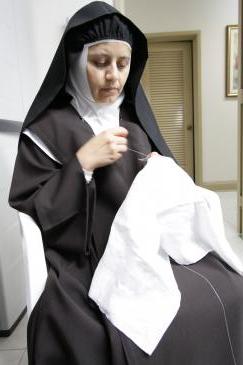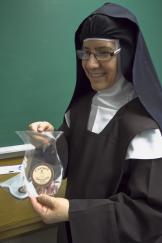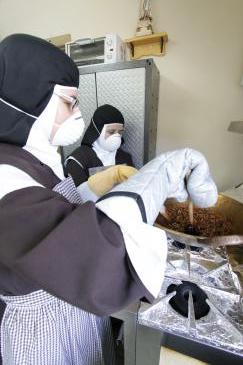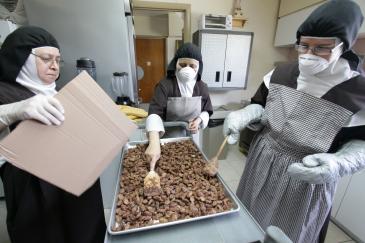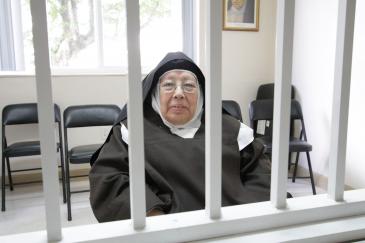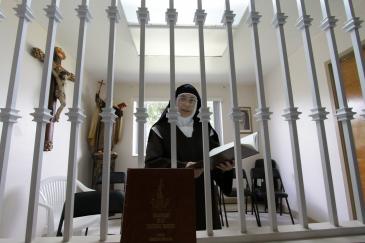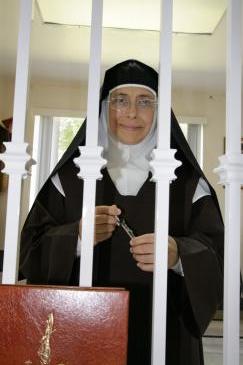By Ana Rodriguez Soto - The Archdiocese of Miami
HIALEAH | Their lives are a paradox.
They have a website, but no Internet.
They make friends and attract vocations, but rarely set foot outside their convent.
They earn just enough money to support themselves, but paid $350,000 for a five-acre plot of land in Homestead.
In a world bursting with noise and tumult, they spend their lives in silence and prayer. But the 11 Discalced Carmelite Nuns who live in the Monastery of the Most Holy Trinity say their silence is full of grace and their prayers return as blessings — for the Church, for the world and for themselves.
The mission of apostolic religious orders — those who live and work in the world — is to speak to people about God, says Mother Teresa Lucia del Inmaculado Corazón. “My mission as a Carmelite is to speak to God about people.”
She is speaking from behind a railing of white wooden bars, in the only area of their Hialeah cloister where the public is allowed. There are simple folding chairs on either side, a table on the visitors’ side. A statue of St. John of the Cross stands in one corner, a painting of St. Teresa of Avila hangs in the other.
Food is delivered through a pass-through that allows no peeking into the kitchen area. Visitors are allowed in the chapel across the hall, but a wooden lacework of bars once again separates them from the nuns.
“The cloister cannot be symbolic. It must be real,” Mother Teresa Lucia explains, quoting from the Vatican document Verbi Sponsa (Instruction on the Contemplative Life and on the Enclosure of Nuns).
ARRIVAL
The Discalced Carmelites are the only contemplative community in South Florida, and they have been tasked specifically with praying for the Church and priests of the archdiocese. The nuns arrived in South Florida on Oct. 13, 2001 at the request of Archbishop John C. Favalora, now Miami’s archbishop emeritus. He was responding to one of the suggestions made during the first-ever archdiocesan synod, held from 1985 to 1988, and to a follow-up request, made in 1997, by Hispanic clergy.
Eight nuns volunteered to make the journey from their 200-year-old monastery in Querétaro, Mexico, a place that has never lacked for vocations. Their rule is that no more than 21 can live in a monastery. Once they exceed that number, a new monastery must be established. Querétaro’s nuns numbered 21 when the archdiocese called.
Among them was Mother Maria del Carmen de Jesus Sacramentado, who entered the cloister just shy of her 17th birthday and has never looked back. That was 66 years ago.
“I never felt a desire to go with the sisters who lived an active life. I always thought of the Carmelites,” said the ever-smiling octogenarian. “I have felt absolutely happy.”
“Our vocation is a gift and a mystery for us,” said another of the original eight, Mother Alba Mery de Jesús, who entered the cloister 28 years ago. “It truly is a mystery of love.”
DAILY LIFE
Their life is regimented, filled with prayer and work. They rise each day around 5:20 a.m. and go to sleep around 10:30 p.m. They pray together for an hour each morning and an hour each evening, followed by another hour of “recreation” — the only time they can speak freely with each other.
“We talk and we sew,” said Mother Blanca Flor de Jesus Sacramentado, who entered the cloister 18 years ago and is currently serving a term as prioress.
Once recreation is over, the nuns take turns doing the work that, along with a food stipend from the archdiocese, enables the community sustain itself economically.
That work entails putting scapulars together, repairing or decorating chasubles for priests and even miters for bishops, washing and ironing purificators, designing and creating chalice palls (the square, hard-backed covers used to protect the consecrated wine), and cooking up batches of healthy granola mix and nutty Carmel Sweets — a Carmelite tradition. They also distribute Communion wafers to local parishes, although they do not bake the bread themselves — they simply purchase it from large suppliers.
“The Lord makes us creative,” said Mother Blanca Flor. “We always have a lot of work, thanks be to God.”
Their work assignments rotate each week and they speak only when necessary. They also take turns completing household chores, such as preparing meals, washing clothes, cleaning the cloister, and beautifying the chapel. Adoration of the Blessed Sacrament is ongoing, with each nun taking a half-hour turn throughout the day.
They have a computer, a printer, a telephone, a fax machine and a library but no Internet. They eat their meals together but in silence, often listening to spiritual readings. News of the outside world is limited to what they need to know for their own safety, such as weather alerts during hurricane season.
PRAYER
“Prayer is everything for us,” said Mother Maricela Reyes de Jesus Maria, who entered the cloister 20 years ago. “We need to go away to be able to have that conversation with God. It’s not about isolating ourselves. It’s looking for those moments of intimacy with Christ.”
The Carmelites see their contemplative lifestyle as the heart of the Church, a heart full of love, a love that empowers the rest of the Church to carry out its apostolic mission in the world. Blessed Pope John Paul II compared their role to that of the lungs, which fill the body with oxygen.
“If love does not function, if it does not pump life, no one would have the strength for so much struggle. That is the richness of contemplative life. United with Christ, and through him, we encompass the whole world,” said Mother Teresa Lucia, who entered the cloister 40 years ago. “My Internet is navigating in the heart of Jesus.”
The very title they use, “mother” rather than “sister”, is a reminder of “our duty to pray,” said Mother Blanca Flor.
As a fellow Carmelite, St. Therese of Lisieux put it: “I am the spouse of Christ and the mother of souls.”
Such isolation may seem strange these days, but “we are normal people,” Mother Teresa Lucia stressed. “People who are not normal are unable to persevere.”
Despite their isolation, the community has grown by three since their arrival. One woman has made her final profession, another has taken temporary vows and a third is a postulant. Several others have gone through a discernment period but decided the Lord was not calling them to the cloister.
“We are not interested in numbers,” said Mother Teresa Lucia. “We try to make sure that the person who comes here feels happy, fulfilled as a woman and as a human being.”
She quoted another famous Carmelite, St. Teresa of Avila, who reformed the 800-year-old order in the 1500s: “No bitter people. No frustrated people. Let those who see you see Christ.”
MONASTERY
Because they have grown, the Carmelites’ Hialeah cloister is now too small for the community. There is not enough privacy, not enough kitchen space, not enough work space.
“This is our whole world. So we need a world that’s a little more spacious,” Mother Teresa Lucia said. Besides, “we need space in order for so many women to remain silent.”
To be sure, they began looking for a cloister nearly as soon as they arrived in South Florida, but place after place failed to match their needs. Then one day in 2008, Mother Teresa Lucia was being driven around Homestead and saw a “for sale” sign on a five-acre plot of land. The realtor was surprised. She thought the nuns wanted a place that was more centrally located.
“We didn’t want to go to Homestead,” Mother Teresa Lucia replied. “But the Lord wants his house in Homestead.”
Since that moment, she said, “the Lord began opening doors.”
The owner was ready to sell and dropped the price to $350,000. Donations began pouring in, ranging from $225,000 from another Carmelite cloister in the U.S. to a can full of pennies, nickels and dimes sent by an elderly woman.
A local medical doctor, Armando Garcia, began reaching out, eventually creating a network of professionals who were willing to donate their time and talent: an architect, an engineer, a banker, a public relations expert, a contractor, a lawyer.
Now the zoning has been approved and the plans have been drawn up, as designed by the Carmelites themselves. The groundbreaking is set for Sept. 7, and construction will start soon thereafter, even though the price tag on the monastery is nearly $5 million.
“We’re starting from faith,” said Mother Alba Mery.
“We have nothing,” said Mother Teresa Lucia. “But the works of God are fulfilled beyond all human possibility. I have no money, but I have a spouse."
Jewish banker meets cloistered nuns
Robert Koffler is now heading team of volunteers who are helping Carmelites with new monastery
HIALEAH | Robert Koffler first met the Carmelite nuns through a friend. The nuns were celebrating a Mass in his friend’s honor and Koffler was invited to attend.
“I really felt something very unique, a peace and spirituality that I had never felt in my life. I was very curious,” said Koffler, a banker by profession and a native of Peru.That was about two years ago. Since that time, according to Mother Teresa Lucia del Inmaculado Corazon, “St. Therese of the Little Flower has engaged in a mad persecution of that man.”
She is referring to the rose petals that Koffler admits keep showing up in the most unexpected places — beginning with the one he found on his chair when he and his friend went to dinner after that first Mass, and continuing with the one he found while on a business trip in Kenya.
“They just appear for no reason, and it must be St. Therese trying to send a message,” said Koffler, the only one in the network of professionals helping the nuns who is not Catholic. He is Jewish.
“I know about the Church but I did not know these nuns existed and I did not know the work they did,” he said. Little by little he got to know them, and “we began realizing that they had this project in mind.”
For the past two years, Koffler and his group have been working toward the Sept. 7 groundbreaking for the new Carmelite Monastery of the Most Holy Trinity.
“The most important thing was to build the group, make the plans and have them approved,” he said. “Now we can begin the fundraising.”
Koffler’s group also created the website for the nuns, which eventually will include a link so that people can donate to the project.
“The idea is to start building” while raising money, he said. “We already have people who are willing to donate.”
JOIN THEM
The groundbreaking ceremony for the new Carmelite Monastery of the Most Holy Trinity will take place Wednesday, Sept. 7, at 9:30 a.m. on the five-acre site at S.W. 209 Avenue and 292 Street in Homestead, with Archbishop Thomas Wenski presiding. Also present will be the 11 cloistered Carmelite nuns who will live there once construction is complete.
Donations can be mailed to the Discalced Carmelite Nuns, 4525 W. Second Ave., Hialeah, FL 33012. For more information, go to www.monasteriodelasantisimatrinidad.org.
The cloister does admit visitors, and they are welcome to celebrate Mass with the nuns on Sundays at 9 a.m. and on special feast days, such as Our Lady of Mt. Carmel in July, St. Therese of the Little Flower in October, and Christmas and New Year.
They have received special permission from the archbishop to go out into the parishes on the weekends to sell their granola and nut treats. Mother Teresa Lucia also has permission to attend Barry University where she has been given a scholarship to learn English.
But “it is not necessary for us to go out,” said Mother Alba Mery. “Our desire is to remain in community.”

